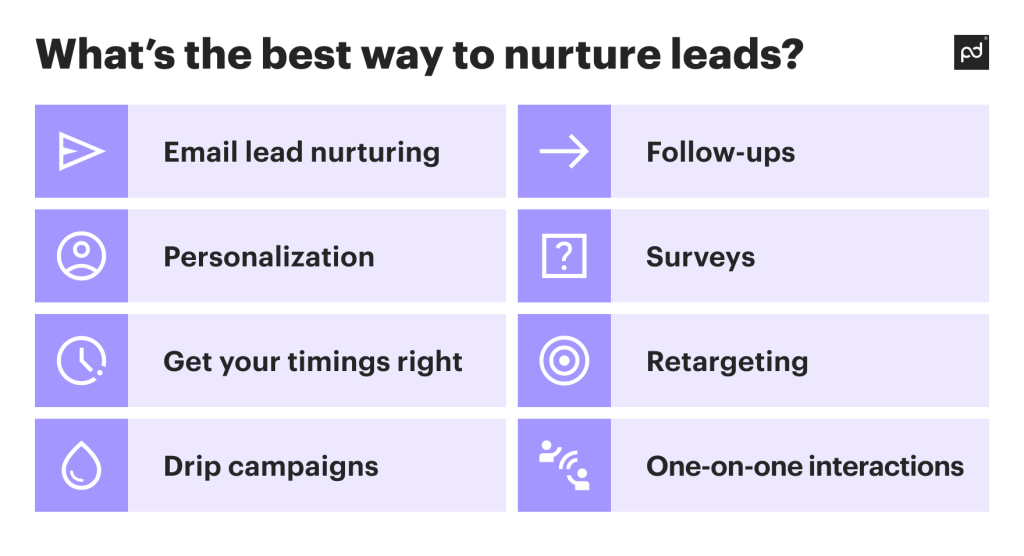Did you know that companies with a strong lead nurturing strategy generate 50% more sales-ready leads than companies that don’t do this?
So, it’s clear that nurturing your leads and prospects is a great way to improve your sales and build lasting customer loyalty.
But to do it properly, a lead nurturing campaign takes some solid strategizing and tactics.
Key takeaways:
- Lead nurturing boosts your conversion rate and builds lasting customer loyalty.
- A good lead nurturing strategy has several stages and tactics adjusted to suit different audiences.
- The right lead nurturing software, platforms, and tools can make the job easier and more effective.
What is lead nurturing?
Lead nurturing is guiding a lead (aka a potential customer) through your sales process to conversion and beyond.
It involves engaging with them, curating their journey through your sales funnel, and building lasting relationships that will keep them returning.
A brand/customer relationship is, in many ways, like any other relationship.
In friendship terms, you’re unlikely to form a strong bond with someone who pesters you to do something for them and never contacts you again.
Instead, you build friendships with the kind of people who offer a more reciprocal relationship: who engage with you, care about your well-being, check in on you, and generally nurture your connection.
If you want your customers to choose your brand over your competitors repeatedly, knowing how to nurture leads is a must.
What are the benefits of lead nurturing?
Lead nurturing has several key benefits. We’ve listed a few of them below.
- It helps to generate more sales-ready leads
- It gives valuable insights into your customers and audience
- It provides a more satisfying customer experience
- It generates lasting loyalty
- It’s cost-effective
- It has great ROI
Common problems lead nurturing can solve
Lead nurturing is a good tactic for solving various common problems, including:
- Lengthy sales cycles. A good lead nurturing program can shorten your sales cycle by guiding leads through the sales journey and nudging them to make decisions faster.
- Pushy sales tactics. Lead nurturing works by building relationships and checking in regularly with customers. If your business struggles to get sales without making pushy pitches that can be off-putting to some, switching to a lead nurturing rather than a hard-pitching strategy can make all the difference.
- Engagement. Lead nurturing is a great way to keep your leads engaged throughout the sales cycle. It keeps your product fresh in the lead’s mind and encourages them to stick with you.
- Lack of customer loyalty. As we already mentioned, lead nurturing is a great way to build loyalty, improve consumer relations, and craft a customer community.
ROI of a successful lead nurturing program
The ROI of a successful lead nurturing program will depend greatly on your business model, the resources you put into it, how extensive your program is, and more.
But, in general, most companies find that lead nurturing delivers an impressive ROI.
Lead nurturing is capable of pulling in far more sales at very little cost to the company — especially if you use the right tech to enhance and enable your lead nurturing process.
The lead nurturing process: What are the stages of lead nurturing?
The stages of lead nurturing will vary depending on your business and customers.
For example, B2B lead nurturing will look slightly different from nurturing B2C leads.
But, in general, you can divide this process into three broad stages.
Marketing-qualified leads (MQLs)
MQLs come onto your radar via marketing, perhaps by engaging with content.
This engagement indicates their interest, but some nurturing from your sales reps can still help to move them along the process to conversion.
Sales-qualified leads (SQLs)
At this point, your sales department will step in to engage with MQLs. This turns them into SQLs.
SQLs are leads who’ve interacted with your sales process in some way, perhaps by viewing a demo of your product or speaking to a sales rep.
They’re likely to convert but still need some nurturing to seal the deal.
Product-qualified leads (PQLs)
PQLs are leads who’ve experienced your product, perhaps by downloading a free trial or trying out a tester version.
They already know the value it can bring and only need persuading that this will benefit their daily life/operation if they buy.
Lead nurturing strategy: What’s the best way to nurture leads?
So, how can you successfully nurture your leads through conversion and beyond?
Here are some popular tactics.

Email lead nurturing
Email lead nurturing involves cultivating relationships with potential customers via a sequence of tailored and personalized emails.
The main objective is to steer leads through the sales funnel by offering valuable information and pertinent content to advance their purchasing decisions.
Email nurturing is arguably the top method for re-engaging leads.
Email personalization
Without personalized emails, getting the results you want is unlikely, regardless of content quality.
Basic personalization tactics include addressing leads by name and analyzing their past purchases and behavior to tailor content to their interests.
Mention something specific to the customer, and add any special details you know about your lead. It all helps to build that unique relationship that is so essential.
Personalization
Creating personalized content relevant to your leads, their situations, needs, and interests is key to effective nurturing.
Remember, it’s all about building relationships with them.
One of the best ways to do this is to engage your leads in ways that are relevant and interesting to them as individuals.
Direct, one-to-one personalization isn’t always possible, but sales and marketing automation means you can get very close to individual personalization if you have the right data.
Look into personalization automation to make your lead nurturing content as personal and relevant as can be.
Create great content
Good, high-quality content will make your nurturing a positive experience for leads and speed up their journey to conversion.
Craft everything with quality, engagement, and entertainment in mind.
From the shortest SMS to full-scale blog posts, put your best efforts into the content you create.
Ensure you’re speaking to your leads in terms they’ll both identify with and enjoy.
Give them well-written, high-value content, and you’ll quickly build positive, lasting brand-customer relationships.
Engaging with the right content at the right time
This can also make a huge difference to the success of your strategy.
You need to leap into action immediately whenever leads show an interest, or you risk losing momentum.
Much of this can be achieved by being responsive.
For example, if a lead emails asking for a quote, have the paperwork ready and send it out right away. If someone messages with a question about your product, be prepared to answer immediately.
To get your timing perfect, automation is your friend.
You can set certain lead nurturing emails, messages, notifications, etc, to go out in response to particular customer behaviors.
For example, if a lead fills their cart and clicks away from your site, automation can send a cart abandonment email after a set amount of time has elapsed.
Get your timings right
Lead nurturing isn’t just about converting first-time customers; it’s also about building loyalty.
A customer who already knows your brand and product is easier to re-engage and re-convert than a new customer, and they’re likely to spend more on your brand over their lifetime than an unpredictable lead.
Don’t let your lead nurturing process end with conversion.
Instead, keep in touch with your customers, and continue to nurture and re-engage them.
Build a positive, loyal brand-customer relationship, and reap the rewards of a positive customer community.
Drip campaigns
Drip campaigns are great for walking that fine line between ‘nurturing’ and ‘intrusive.’
A good one won’t bombard the customer with pushy ‘Buy now!’ messaging.
Instead, it will ‘drip’ a series of perfectly pitched nudges and incentives designed for different stages in the buyer’s journey.
For example, an email drip campaign for eCommerce might start with a cart abandonment email reminding the customer to check out.
It may then progress to notifications about items in their cart (for example, if they change price or if discount codes for them become available).
After the customer converts, the ‘drips’ will thank the customer, ask them for their feedback, and notify them of similar items they may be interested in.
Follow-ups
If you’ve sent a quote or a proposal or given a potential customer a demo, following up a few days later is a good way to nurture leads.
A quick email reminding them of what you proposed/discussed and how it could benefit them will help keep your product or project fresh in their minds. It may also encourage them to consider how close or likely they are to purchase.
Surveys
Surveys are crucial for lead nurturing as they offer valuable insights into potential customers’ needs and preferences.
Engaging directly with leads through surveys allows you to tailor communications and offers based on their feedback, providing a glimpse into their preferences akin to “reading their minds.”
Retargeting
If your email marketing is working, try to incorporate retargeting on various platforms alongside it.
By harnessing the power of newsletters and retargeting campaigns, you ensure your business remains top-of-mind for prospects.
Retarget your leads with social media and display ads.
Social media retargeting
This strategy is invaluable for lead nurturing efforts.
Social media retargeting displays tailored ads to users who’ve engaged with your website, app, or other online content, such as visiting pages or adding items to a cart.
Remember, it’s important to match your advert with the exact customer profile you want to appeal to and the right social platform.
Display retargeting
Display retargeting involves presenting visual ads to users across different websites.
These ads can appear as banners, images, or other visual formats.
One-on-one interactions
Undoubtedly, one-on-one conversations offer the most personalized interactions with leads.
Amid discussions of automation, retargeting, and campaigns, it’s easy to overlook the significance of individual touchpoints. There are three main ways to do this.
Meet with leads in person
Meeting leads in person is among the most effective methods to establish trust and rapport.
Through face-to-face interactions, you can foster deeper connections and gain a clearer understanding of their needs, humanizing the relationship beyond mere advertising interactions.
Connect with leads on social media
Meeting leads in person isn’t always feasible, especially if your target audience is spread across the globe.
In such cases, one-on-one interactions on social media serve as the next best option. Platforms like Twitter, Facebook, and Instagram should be your go-to tools.
Let your Sales Development Reps (SDRS) take care of lead nurturing
SDRs specialize in lead generation and qualification, but they can also be valuable for nurturing strategies.
They’re adept at identifying and engaging potential leads, making them ideal for fostering relationships in the early sales funnel stages.
Moreover, they excel in initiating conversations, understanding prospect needs, and articulating product value.
Their strengths in initial outreach, follow-ups, and rapport-building are all vital components of successful lead nurturing efforts.
Advanced practices to take your lead nurturing to the next level
These advanced practices can give a serious boost to your lead nurturing strategy.
- Use the right tools and technologies. There’s plenty of fantastic tech out there that can help you be more responsive, relevant, and timely in your lead nurturing.
- Make sure marketing and sales are aligned. Marketing and sales need to work closely together on lead nurturing. Make sure the two departments are communicating well and cooperating easily and effectively.
- Engage wherever possible. Use multiple channels to engage with your leads at as many points as possible along their conversion journey.
- Focus on long-term loyalty over immediate conversions. Building lasting customer relationships will benefit you more in the long run than pushing for immediate sales.
The best lead nurturing tools and technologies
A good tech stack can make your lead nurturing more efficient and effective. Here are some of the tools you need.
CRM
A good customer relationship management platform will give you all the information you need to nurture your customers effectively.
It can collect and store essential data that helps you understand them better, as well as log things like interactions, purchase history, and so on.
Lead capture software
LC software will collect and organize information on potential leads.
For example, if someone clicks on your ad, it will quickly gather as much information on that person as it can, qualify them as a lead, and forward their data to the relevant platform.
Marketing automation
There are hundreds of marketing automation options that can make lead nurturing easier.
For example, email automation can personalize your email templates and set up certain messages to go out at certain times or in particular situations.
Secure proposal/quote software
Timing is everything, so you must have the right links, documents, etc, ready to go out.
Good, secure quote and proposal software can help organize your sales workflows so everyone has the paperwork they require when needed.
How marketing automation can help your lead nurturing strategy
Marketing automation has revolutionized lead nurturing.
From behavior-triggered messaging to personalization and data gathering, it makes it easy for companies and enjoyable for customers.
For example, marketing automation enables companies to hone their lead-nurturing message timings to perfection.
It also personalizes those messages in response to customer data and preferences, ensuring nobody feels like a robot is talking to them.
Marketing automation can also gather and sort vital customer data at speed, saving human marketers a ton of time and providing the kind of accurate insights humans would struggle to produce from raw numbers.
All in all, if you want a successful lead nurturing strategy, marketing automation is a must.
Lead nurturing examples
Let’s now look at some lead nurturing examples.
Cart abandonment emails
A cart abandonment email is a good way to gently remind customers of their interest in your product.
Some companies use them as part of drip campaigns, which progress from simple reminders to notifications if the price of something in the cart changes (and perhaps even discount offers).
Feedback requests
Done right, asking for feedback shows the customer you respect their opinion and want to deliver the kind of service they’ll appreciate.
It’s also a great way to continue nurturing a lead after conversion.
Some companies tailor their lead nurturing strategies based on individual customer feedback.
For example, if a buyer indicates that they don’t like the volume of emails received, the company will instruct its automation software to reduce these.
Anniversary celebrations
All good relationships have special anniversaries. Why should brand-customer relationships be any different?
Anniversary messaging can be a fantastic way to nurture your leads and build loyalty.
For example, you might send someone a celebratory email to mark the anniversary of their first purchase, perhaps with a discount code included.
Or you could send them a small gift and an e-card on their birthday.
What is lead nurturing content?
Lead nurturing content is high-quality, intensively targeted content to strengthen relationships between brands and their customers.
It should be well-researched, relevant to the interests and situations of its target audience, and position the brand as being aligned with customer needs.
Lead nurturing content can be anything from blog posts to emails.
The important thing is that it addresses the needs of consumers at specific points in their customer journey and helps bring the brand and customer closer together.
Five lead nurturing ideas that work
Personalize everything
Personalization not only adds that all-important human touch to your content, but it also makes it more relevant to your leads.
Remember anniversaries
Discounts, recaps, and content that celebrates the personal connection between an individual customer and your company help your buyers feel valued.
Schedule appointments
Incorporate lead appointment setting tech into your website so customers can more easily make appointments to talk to your representatives.
Develop a likable brand persona
It’s easier for a customer to relate to and develop loyalty toward a likable brand persona than it is something more generic.
Put the customer in the driver’s seat
Drip campaigns can feel intrusive, so give the customer the power to turn them off whenever they want.
Save time with PandaDoc when it comes to lead nurturing
PandaDoc makes lead nurturing a simple process for companies.
Shorten your sales cycle and nurture leads with quick, slick document workflows.
Share docs instantly, edit collaboratively, and integrate them with important platforms like your CRM.
PandaDoc can help at every stage of the lead nurturing process, from proposals and quotes to conversion and follow-ups.
Book a demo today to see how it works.
Disclaimer
PandaDoc is not a law firm, or a substitute for an attorney or law firm. This page is not intended to and does not provide legal advice. Should you have legal questions on the validity of e-signatures or digital signatures and the enforceability thereof, please consult with an attorney or law firm. Use of PandaDoc services are governed by our Terms of Use and Privacy Policy.


